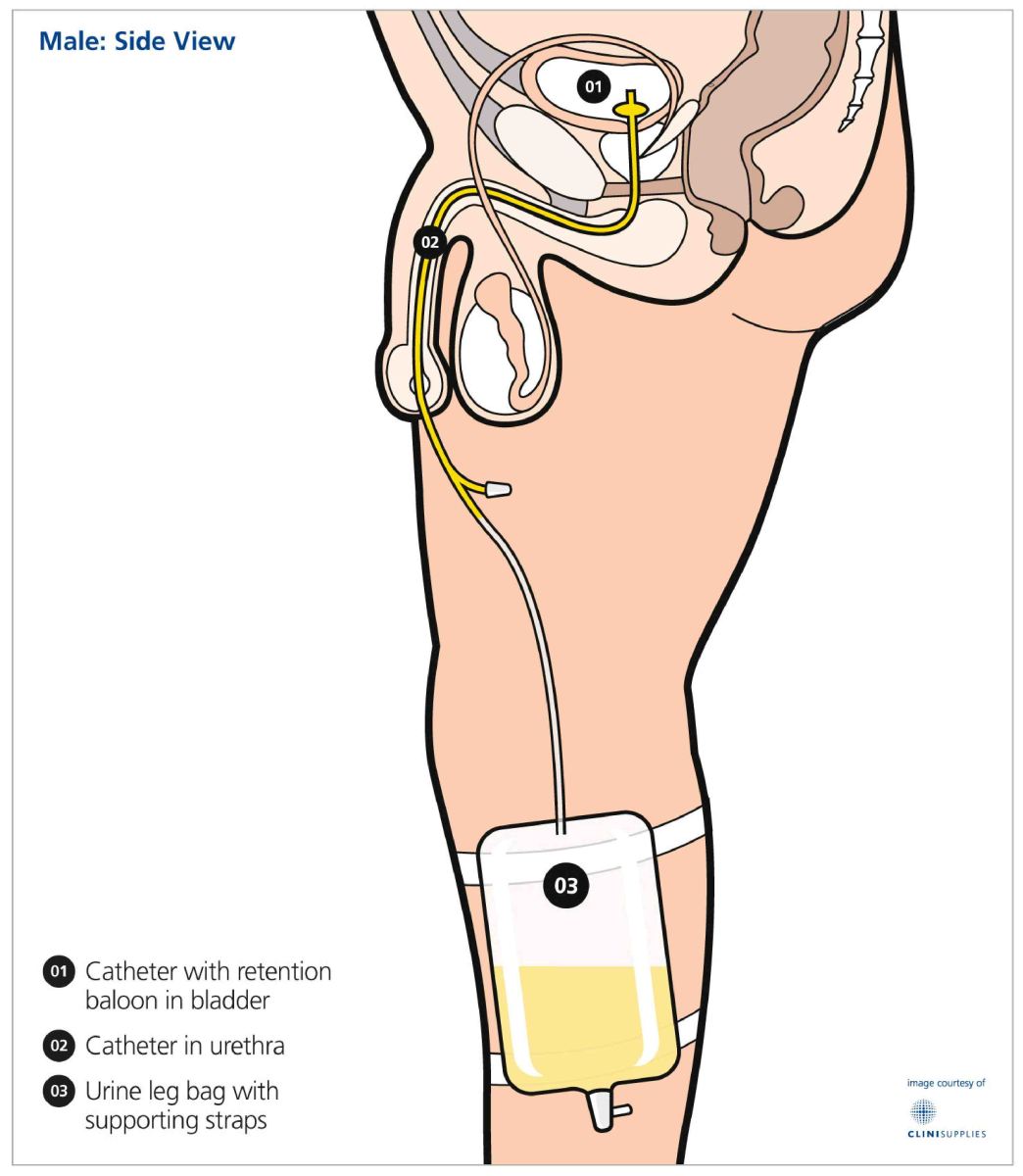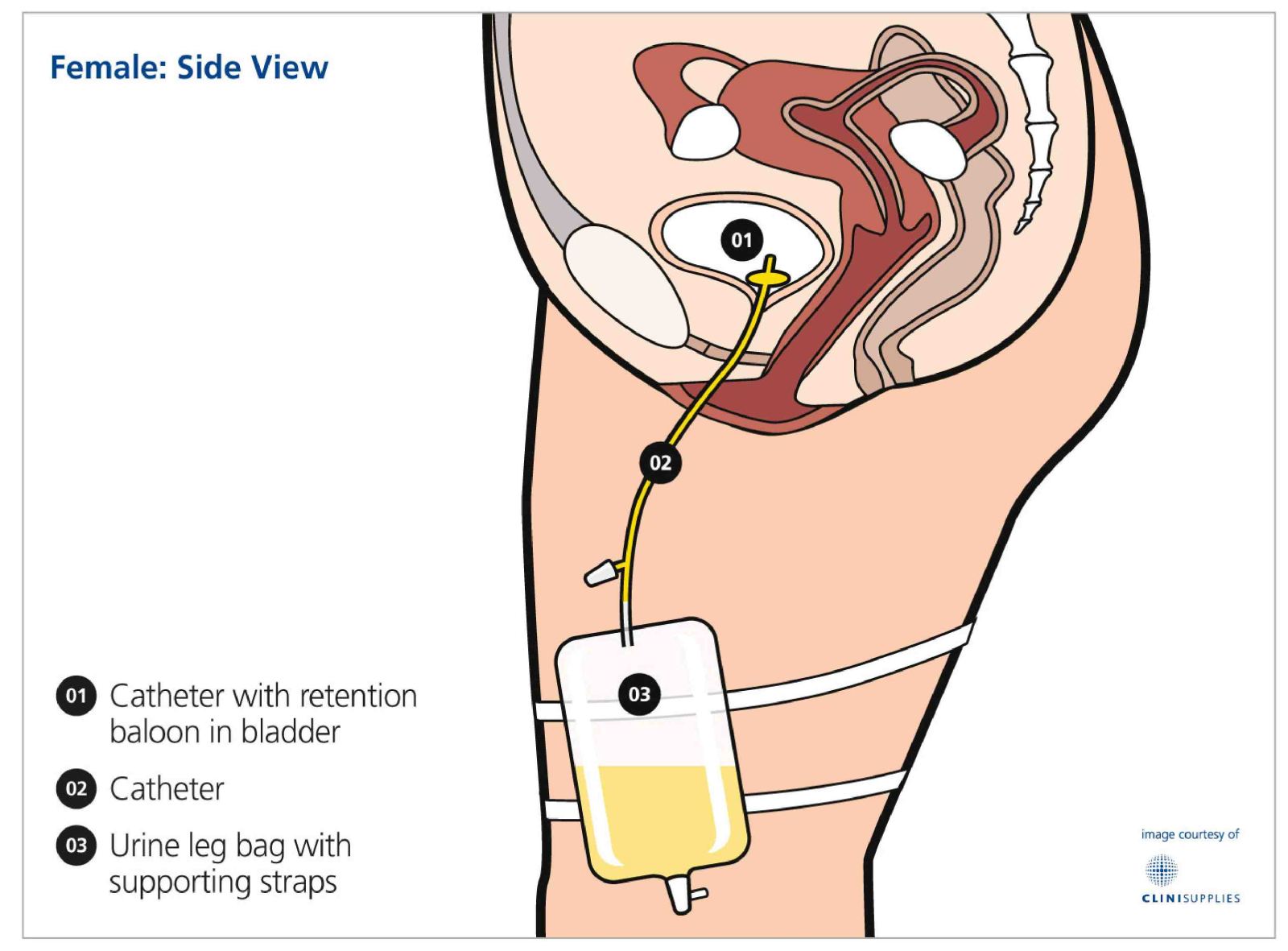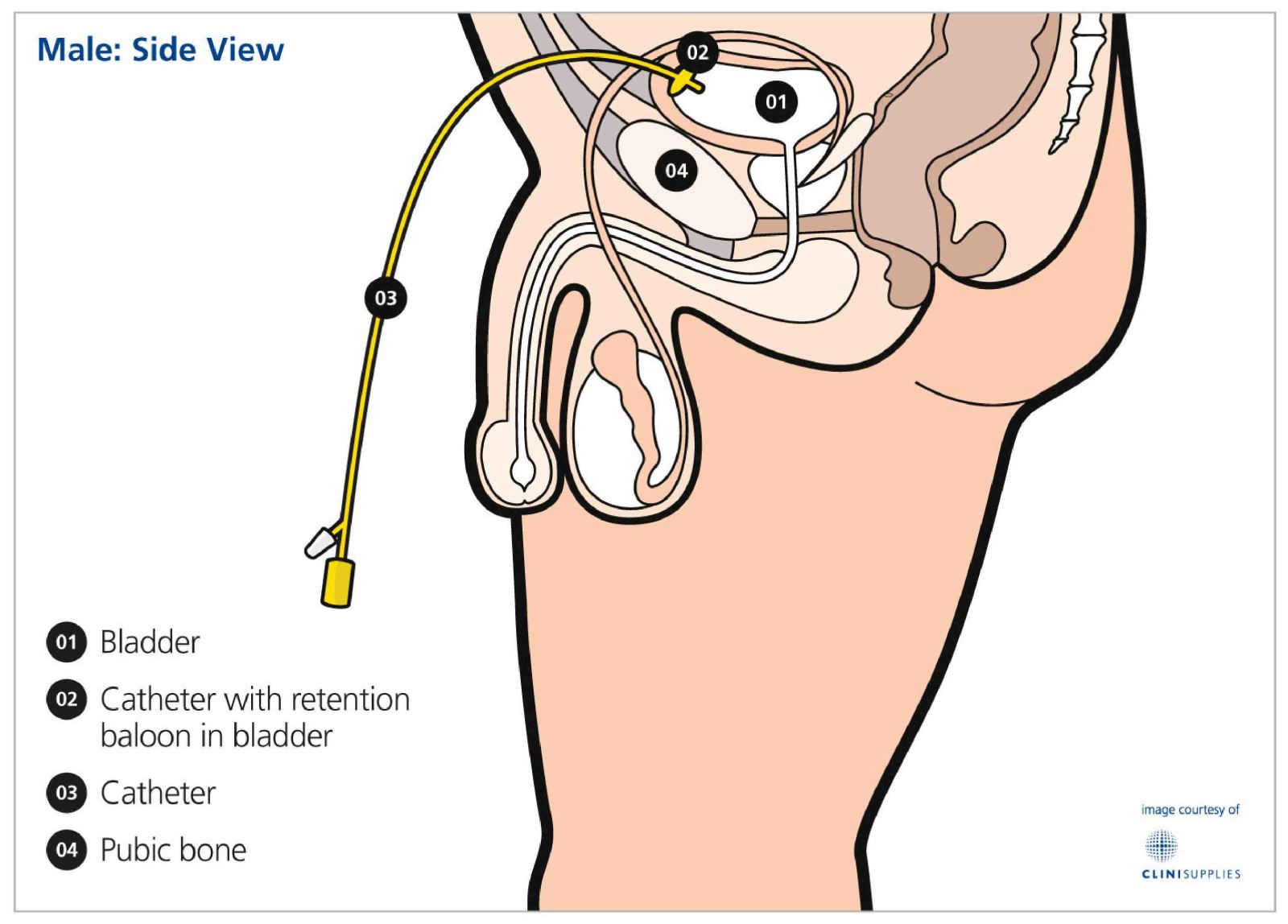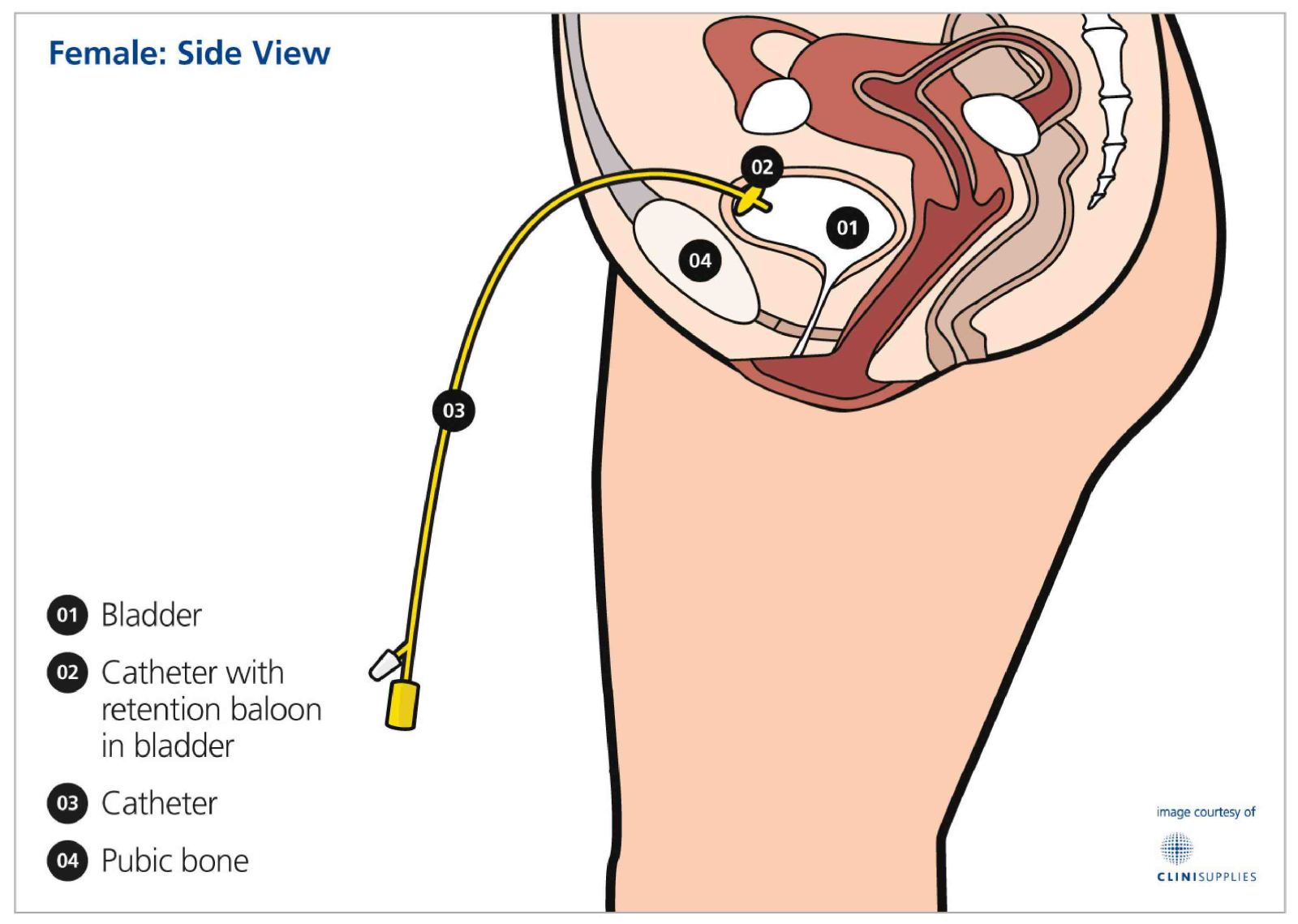What is a catheter?
A catheter is a small tube placed into your bladder to drain urine. Your doctor will have explained why you have a catheter in place, it may be due to:
- Inability to pass urine
- To allow healing after urology surgery
- Management of urinary incontinence
- To allow bladder function tests
The catheter has been introduced into your bladder via your urethra or bladder outlet, or directly into your abdomen (also known as a suprapubic catheter). The catheter is held in place by a balloon filled with water and will not fall out in normal use.
Most catheters can be left in place for up to 12 weeks. Your doctor / nurse will tell you when your catheter is due to be changed.
Leg bag
The catheter must be attached to a drainage bag or leg bag. Urine drains directly into this bag.
- The bag is to be worn during the day
- The tubing may come in two lengths so it can be worn on your calf or your thigh
- Empty the leg bag using the drainage tap at the bottom of the bag
- The bag should be emptied every 3-4 hours or before it becomes over-full (depending on how much you drink)
- Always keep the leg bag LOWER than the bladder
- The leg bag should be changed every two weeks
To change the leg bag
The leg bag should be changed every two weeks, or if it is damaged. The catheter and leg bag connection should only be disconnected when you change your bag.
- Wash and dry your hands well
- Place a towel on your lap between you and the catheter, with your replacement leg bag beside you
- Pinch off the end of the catheter and withdraw the fluted end of the leg bag tubing from the catheter outlet
- Remove the protective cap from the new leg bag and firmly insert the fluted end into the catheter outlet
- Secure the new bag to your leg using the straps provided
- Empty urine from the old drainage bag into the toilet
- Dispose of the old bag in the rubbish
- Wash and dry your hands
Catheter valves
You may use a catheter valve (also known as a flip-flow valve or tap) as an alternative to a leg bag, depending on advice from your urologist or urology nurse specialist
Catheter valves fit directly to the end of the catheter, and urine is retained in the bladder until the valve or tap is released
You will need to open the valve to drain your bladder at regular intervals (3-4 hourly) or when your bladder feels full
- The valve should be changed weekly
Night bag
At night a larger capacity bag should be attached either to the outlet of the leg bag, or to the catheter valve if one is being used. The night bag has longer tubing allowing greater movement in bed.
To fit the night bag
- Wash and dry your hands well
- Remove the coloured cap from end of the new night bag tubing
- Connect the fluted tip at end of the night bag tubing into the bottom outlet of the leg bag
- Open the outlet tap on the leg bag: urine will then run freely into the night bag
- Place the night bag into a container, eg plastic container, to contain possible leakage from the night bag. The night bag must be lower than your bed to aid drainage.
To remove the night bag
- Close the leg bag outlet or catheter valve and remove fluted end of the night bag tubing from the outlet of leg bag or catheter valve
- Empty urine from the night bag into the toilet or suitable container using the drainage tap
- Wash the night bag with warm soapy water and hang up to dry
- When dry, store the night bag in a clean sealed plastic bag
Follow-up care
- If your catheter is to remain in permanently, it will need to be replaced periodically as determined by your urologist.
- If you are required to have the catheter removed, this may be performed at Urology Associates. You will receive an appointment for this.
- If your appointment is for a trial of void, be prepared to drink plenty of fluid during the day
- The length of time you will need to stay and the success or failure of your trial of voiding cannot be predicted
- Please contact Urology Associates if you have not received a follow up appointment 2 weeks after your catheter has been inserted
Supplies
If you require a catheter for a long term period, we will have arranged your catheter requirements through the District Nursing service. They will contact you once they have received a referral.
Additional catheter supplies can be obtained from Maudes Online or the Nurse Maude shop.
Personal hygiene
- Wash and dry your hands thoroughly before and after changing your catheter
- Wash the area around your bladder outlet and catheter daily
- Showering is preferable to bathing
- Leave the leg bag in place when showering
- Use unscented soap and warm water and rinse well to avoid irritation.
- Dry the area well, including leg bag and straps with a soft towel
- Avoid using talcum powder or any creams around this area, unless prescribed by your doctor
Sexual intercourse
- Both partners should wash their genital area before and after intercourse
- Women: tape the catheter out of the way, forward onto the abdomen
- Men: fold the catheter tubing down over the erect penis, apply a condom, and tape it in place
- Use plenty of water soluble lubricant (KY jelly). Vaseline is not water based and must not be used.
- If your catheter is causing you problems during sexual intercourse discuss this with your nurse or urologist
Problem: Urinary infection
Signs
- Smelly, cloudy urine
- Urine bypassing the catheter and leakage around the catheter
- Abdominal pain
- Bleeding
Treatment
- Increase your fluid intake
- Try taking a glass of cranberry juice per day as a preventative measure
- Contact your GP who may take a urine sample and prescribe a course of antibiotics
Problem: There is very little or no urine in your bag for several hours
Cause
- The tubing could be kinked or bent
- The bag is above bladder level
- Low fluid intake
- Constipation
- Blocked catheter due to debris
Treatment
- Check the placement of catheter tubing and drainage bag
- Try moving or walking around: this may dislodge a blockage
- If 4 hours or longer pass and no urine passes, then contact your doctor or nurse
Problem: Blood in the urine or around the catheter
Cause
- Irritation of bladder or urethra by the catheter or infection
Treatment
- Increase your fluid intake
- If the bleeding persists or is still heavy after 2 days contact your GP who may take a urine sample and prescribe a course of antibiotics
Problem: Bladder spasm / leakage around your catheter
Cause
- The bladder can be irritated by the catheter and may attempt to expel the catheter. This forces urine out around the catheter causing pain and leakage.
Signs
- Lower abdominal pain
- Leakage of urine
- Decreased urine in the catheter bag
Treatment
- Take regular 4 hourly paracetamol while pain is present
- Take regular oxybutynin (anti-spasmodic) tablets to relax the bladder as prescribed by your doctor
- If pain persists, contact your doctor or nurse
Problem: Catheter falling out or leaking
Cause
- Faulty balloon or damaged catheter
- Bladder spasm
Treatment
- If you can pass urine call your nurse in office hours
- If you cannot pass urine yourself, and the bladder becomes painful, seek immediate help from your GP





